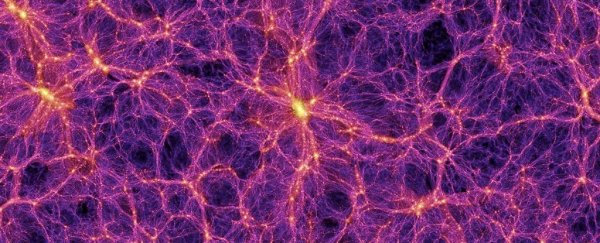We now have even more evidence that our galaxy sits inside an enormous void, and it could help settle a disagreement over the rate at which the Universe is expanding.
The new study contradicts a basic assumption about how special our place is in the cosmos, and suggests that we're sitting in what could be the biggest known void in the Universe.
Not that science aims to be a big buzzkill, but researchers tend to act on the basic idea that there's nothing special about our time and place in nature until we have some reason to think otherwise.
This assumption, based on the cosmological principle - the distribution of matter across space is relatively even when seen from a big enough distance - means that when we look up, our perspective on the Universe shouldn't be considered particularly unique.
On scales larger than about 250 million light-years, this typically holds true, but at some point, the Universe starts to look a little like, well, Swiss cheese.
Holes (or voids) in the distribution of matter can exist on various scales, from gaps in where we'd expect stars in the middle of a galaxy to entire collections of voids that give the appearance of a 1.8 billion light year wide "cold spot" in the Universe's background radiation.
With the concept of dark matter, the picture of the Universe is now one of clusters of galaxies linked by long, invisible filaments, with bubbles containing less stuff in between.
The idea that the Milky Way sits in a backwater rather than a cosmic urban centre was proposed in 2012 by astronomers Ryan Keenan, Amy Barger, and Lennox Cowie, who published their research on what is now referred to as the KBC void.
Their calculations estimated that the void could be a pretty big one, too. At about 1 billion light-years across, it would be seven times larger than the average hole, putting it in the running for the biggest known void in the Universe.
One of Barger's students, Ben Hoscheit from the University of Wisconsin-Madison, has now weighed on her previous work, showing variations in the structure of the early Universe still match up with their observations.
"What Ben has shown is that the density profile that Keenan measured is consistent with cosmological observables," said Amy Barger from the University of Hawaii's Department of Physics and Astronomy.
This consistency is important – the fact we probably sit in a void isn't just a piece of interesting trivia, it affects how we determine an important cosmological factor.
The Hubble Constant is a number that describes how the Universe is expanding, estimated by measuring the way light from distant objects stretches as they move, and then working out how far away they are.
While we've known for nearly a century that the Universe is expanding, but in recent decades, different calculations on the constant have suggested the rate of expansion was slower in the early Universe.
"No matter what technique you use, you should get the same value for the expansion rate of the Universe today," says Hoscheit.
These numbers are based on the cosmological principle, so if there is something a little different about our spot in the Universe, we might need to take that difference into account.
For example, one constant as measured by the Hubble Space Telescope relies on supernovae that explode in galaxies nearby (and therefore nearby in time) with a predictable amount of energy.
Measurements using data taken by the Planck observatory instead use the Cosmic Microwave Background (CMB).
One interpretation for the difference is the Universe was expanding slower when the radiation from the CMB was emitted back when the Universe was young, and is now expanding faster.
Another is the constant isn't the same locally as it is in the distance.
Minute differences in the CMB are believed to end up as large-scale structures in the Universe, including the clusters of galaxies surrounding relatively empty voids. It's those tiny baby bubbles that Hoscheit looked at.
"Photons from the CMB encode a baby picture of the very early Universe," says Hoscheit.
"But, in fact, those tiny temperature differences are exactly what allow us to infer the Hubble Constant through this cosmic technique," said Hoscheit.
Hoscheit presented his findings at a recent meeting of the American Astronomical Society, so they're yet to go through the peer-review process. Keeping all of that in mind, the KBC void and its role in the Hubble Constant is still far from established.
It also doesn't rule out an accelerating Universe, even if it does introduce questions on how we should be calculating it.
In any case, Hoscheit's work shows there aren't any observations we can currently make to show the void hypothesis is empty.
"One always wants to find consistency, or else there is a problem somewhere that needs to be resolved," says Barger.
The research has been presented at the 2017 American Astronomical Society meeting.
